Key Takeaways: What Is Agile?
- Agile is a set of values and principles that puts the customer above processes and documentation.
- The Agile project management approach is versatile and favors face-to-face communication, adaptability and phases of continuous improvement.
- Many project management methods now incorporate Agile concepts and values found in the Agile Manifesto.
In 2001, a group of developers called the Agile Alliance met to discuss alternative approaches to the overly-structured traditional project management methods that hindered software development. The resulting values and principles they came up with would change the face of project management. So, exactly what is Agile?
In this guide, you’ll find out why the Agile Manifesto was created, how Agile methods changed the face of project management and why you should consider adopting iterative and highly flexible Agile project management methodologies for your modern team. Let’s dive in.
What Is Agile Project Management?
Before going any further, we will take a quick look at what Agile project management is. The Agile Alliance came up with the Agile Manifesto. The manifesto is a list of values and principles that favors individuals over tools, working software over documentation, collaboration over negotiation and responding to change over following a plan.
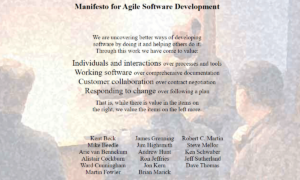
Agile project management is an iterative way of working that champions flexibility, open communication, continuous improvement and customer (stakeholder) involvement throughout a project’s life cycle. This approach radically differs from traditional project management methods that rely on mountains of documents and rigid schedules.
Agile practices allow teams to pivot and change course with ease when new demands are made. Agile methodologies also favor constant face-to-face communication over documents to ensure all parties are on the same page every step of the way. In a way, Agile methods are living, breathing methods that put customer satisfaction first.
Key Agile Concepts
As you dig into Agile, you’ll find a world of terminology and concepts that might confuse you initially. However, as you and your team develop an Agile mindset, you’ll have no issues understanding the lingo and concepts used throughout Agile projects.

to create notes for daily meetings, a key component of Agile.
Key Agile concepts include “user stories,” “personas” and “milestone retrospectives.” User stories are a small unit of work that adds value to the product. Personas describe the type of people who might use the product. Milestone retrospectives are meetings at the end of sprints and iterations.
Below, you’ll find a table with several common concepts Agile teams must understand to succeed.
| Agile Concept | Definition |
|---|---|
| User Stories | Small units of work that are developed in conjunction with the client. Each User Story must add value to the end product. |
| Milestone Retrospective | A meeting to discuss wins, losses, problems and what can be done in the future to improve team processes. |
| Team | A small group that works on the same project. Most of the team are full-time members. A small percentage may be part-time. |
| Personas | If needed, the team will develop made-up backstories of hypothetical users that the product is targeting. |
| Incremental Development | Agile teams prefer to use the incremental development method, which takes the previous working version of the software and adds user-visible improvements. |
| Daily Meeting | The team meets at the same time and place daily to discuss the project and its progress. In scrum settings, these meetings are called daily scrums. |
| Iterative Development | The iterative development process that Agile teams follow allows them to repeat software development activities and revisit previous work products. |
Agile Software Development
Before the Agile Manifesto was created, teams working on software development projects used traditional project management approaches, like Waterfall, to complete projects. The Waterfall method is document-heavy and requires a development team to complete entire phases of work before implementing changes and testing software.
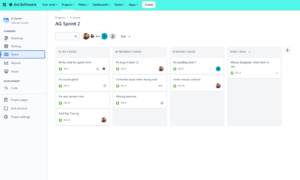
thanks to its user-friendly interface and powerful tools.
With an Agile framework in place, Agile teams are free to communicate with clients whenever they want. Agile teams can collaborate, identify problems quickly and incorporate and test software changes on the fly instead of waiting until the end of a project cycle. This is why Agile methods are so commonly used in software development projects.
Knowing that Agile methods were developed for software developers might make you wonder if can be used in other areas of work. The good news is Agile processes can and have been implemented successfully by many teams in a wide range of industries.
Benefits of Using Agile Project Methodology: Why Choose Agile?
Those working in manufacturing, marketing, production, human resources, digital services and more have incorporated an Agile approach into their work because there are so many benefits. Below, we’ll quickly cover some of the industries that are saying goodbye to traditional methods.
Marketing Teams
Marketing teams can benefit from Agile methodologies. Thanks to Agile Kanban boards, they can quickly create tasks, assign team members, add due dates and see where a particular campaign or task associated with the project is sitting in the pipeline.
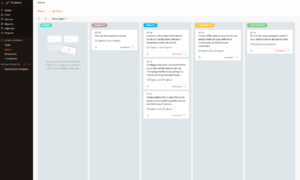
On top of this, constant face-to-face communication with project stakeholders means cross-functional marketing teams can quickly react to changing market trends, social media requests and changes to branding. Agile marketing teams can also adjust campaign parameters on the fly with minimal fuss.
If you want to switch to Agile methods and need software that provides robust Kanban boards, lists and other Agile tools, check out Zoho Projects (here’s our Zoho Projects review).
Manufacturing and Product Development
Agile principles have been used in manufacturing and product development for decades. In fact, it was Toyota in the 1940s that made Kanban and Lean methods popular. By using Agile and Lean methods, manufacturers and product developers can identify work bottlenecks, wasteful processes and whether any team members are overburdened with work.
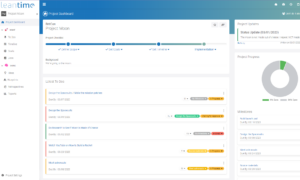
During the manufacturing or product development cycle, client feedback can be incorporated at any time, product iterations can be planned quickly and deliverables can be produced rapidly. If you’re interested in software that mixes Agile and Lean methods, check out our Leantime review.
Human Resources
Whether you use software like monday.com to help you track applicants moving through a hiring phase or Asana to organize employee performance evaluations, HR teams can efficiently manage complex processes without fuss.
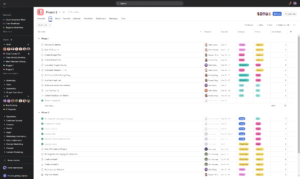
Cross-functional teams can collaborate on a wide range of topics and incorporate employee feedback quickly, which could help improve employee satisfaction and retention. HR teams can take a page from a Scrum team’s book and incorporate daily huddles to discuss issues or use sprints to develop employee incentive programs. The sky’s the limit.
Types of Agile Methodologies
As you’re well aware by now, Agile isn’t a methodology. However, numerous methodologies use Agile principles and concepts. We’ll take a quick look at a few Agile methodologies that will serve you well.
The list below shows just a few Agile methodologies that can be used by software development teams and other groups. Scrum and Kanban are the most popular Agile methods due to their ease of use and ability to get the best out of teams. However, other Agile project management methodologies can also help lead you to project success.
7 Popular Agile Methodologies
- Scrum: Scrum masters break work into small chunks (sprints) and lead teams through daily meetings, so members can discuss project progress and solve problems.
- Kanban: A visual approach to Agile that provides eye-opening global project overviews.
- DSDM (Dynamic Systems Development Method): An Agile method that focuses on full project life cycles rather than small chunks of work.
- Extreme Programming (XP): A highly adaptive Agile approach with short sprints for volatile projects.
- Scrumban: A hybrid Agile project methodology that combines elements of Kanban and Scrum.
- Adaptive Software Development: An adaptive project framework that focuses on continuous adaptation and learning.
- Lean: An Agile method that forces entire organizations to identify waste and make production more efficient.
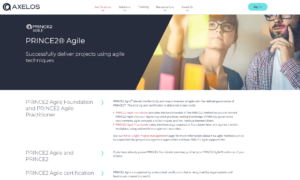
Lean is another popular Agile methodology. Not only does Lean mix well with Kanban, but it also complements more complex methodologies like PRINCE2 and Six Sigma, which have Agile variants. Extreme Programming and Adaptive Software Development are also highly respected methods for feature-driven development in the software industry.
The good news is that most modern project management software, including many included in our roundups of the best project management software and the best free project management software, supports these ways of working. You can also find many project management certifications that can help you learn about these methods.
Best Agile Project Management Software
Many project management software platforms can be used to get the most out of Agile teams. Our team of experts rounded up the best Agile tools for project managers to use, so take a look at the list to see some options. Below, we’ll take a quick look at two platforms that stand out.
1. monday.com
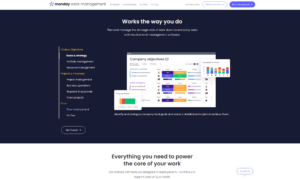
Pros:
- Easy to learn
- Competitively priced
- Friendly user interface
Cons:
- Limited free plan
- Poor security on cheap plans
- Collaboration could be better
monday.com regularly tops our best-of lists for project management software. This Agile-forward software features many tools, including Kanban boards (which can be used for Scrum), lists, calendars and customizable dashboards. It also offers support for integrations and automations.
monday.com is easy to use, gives you templates for multiple working styles and jobs, and has some of the most affordable plans in the industry. If you would like to learn more about pricing, check out our monday.com pricing guide. Read all about the platform in our monday.com review.
- Maximum users: 2, Kanban Board, & list
- Minimum users: 3, Price per user, Basic features
- Minimum users: 3, Price per user, Advanced features
- Minimum users: 3, Price per user, Expanded features
2. Jira
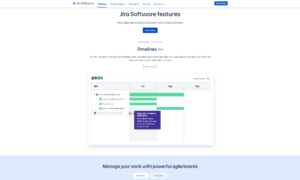
Pros:
- Robust free plan
- Easy to use interface
- Comprehensive feature set
Cons:
- Lacks versatility
- No discount for small teams
- Lots of technical terminology
Jira is for you if you need robust software that supports Agile teams. Designed with software developers in mind, Jira features user-friendly Kanban boards that help manage sprints with ease. There are integrations with many leading platforms, support for audit logs, retrospective meetings and daily scrums via Confluence, and much more.
There’s a great free plan for small teams, and there are paid plans for budgets of all sizes. If you’d like to learn more about Jira’s plans, check out our Jira pricing guide. If you want the skinny on Jira’s tools and features, head over to our full Jira review.
- Max. 10 users. unlimited boards, reports and insights; backlog; basic roadmaps; 2GB of storage; community support
- Annual price is for 10 users; with more than 10, annual pricing changes based on the number of users. Monthly pricing changes with teams over 100.
- Annual price is for 10 users; with more than 10, annual pricing changes based on the number of users. Monthly pricing changes with teams over 100.
Final Thoughts: Understand Agile Project Management
Traditional project methods have their place and are still the standard for some industries, like construction (check out our roundup of the best construction project management software). However, Agile methodologies are taking over due to their versatility and flexibility.
We live in a fast-paced world where decisions must be made quickly. If you’re unwilling to try Agile development methods, you might eventually be left behind, and neither you nor your clients can afford that.
Do you use traditional methods? Are you considering a switch to Agile ways of working? What’s your favorite Agile approach? Let us know in the comments, and as always, thanks for reading.
FAQ: Agile Methodology
-
Agile is a series of principles and philosophies that help guide project managers and their teams through projects that require flexibility, strong communication and collaboration, and timed phases of work.
-
Per the Agile Manifesto, the four principles of Agile are individuals and interactions over processes and tools, working software over comprehensive documentation, customer collaboration over contract negotiation and responding to change over following a plan.
-
Agile is not a project management methodology but a set of guiding principles and philosophies that Agile methods, like Scrum, are built upon.
The post What Is Agile Project Management? 2023 Guide to the Methodology appeared first on Cloudwards.

